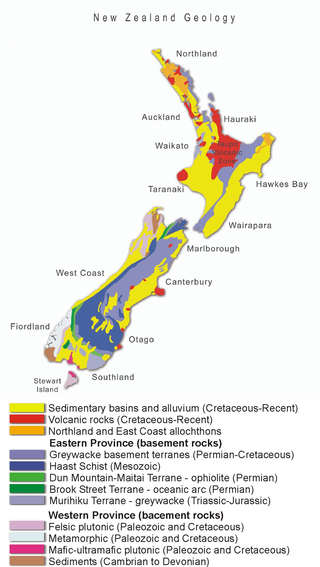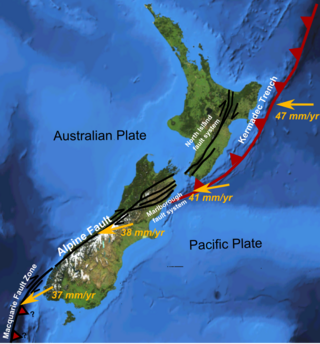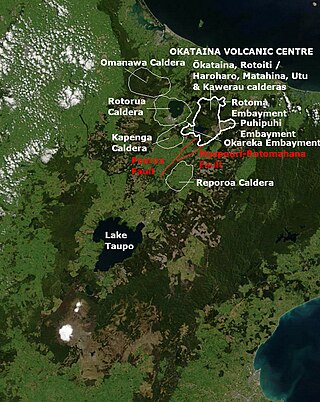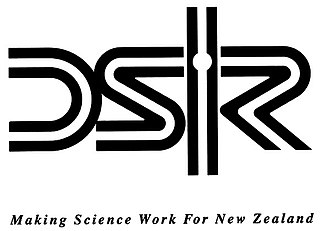Martin Everardus Reyners (born 1950) FRSNZ is a New Zealand geophysicist and seismologist. He is a principal scientist at the Institute of Geological and Nuclear Sciences (GNS Science), Lower Hutt, and is a specialist in subinduction zones, especially in relation to New Zealand.
He was educated at St Peter's College, Auckland and the Victoria University of Wellington, completing a PhD in geophysics in 1978. [1]
His work has "enabled three-dimensional tomographic imaging of the structure of the colliding plates" [2] and has so shown the modus operandi of plate tectonics under New Zealand, especially in relation to the Taupo Volcanic Zone, which is "the most frequently active and productive silicic volcanic system on Earth." [2] He has cast light on the mysterious termination of volcanic activity at Mount Ruapehu and its non-continuation with the subducted Pacific Plate further south under New Zealand" [2] He is currently examining why the New Zealand tectonic plates are jammed together in some places because, if these unjam, there could be a large earthquake [2]
He is a fellow of the Royal Society of New Zealand (FRSNZ), and has been awarded the Hochstetter Lectureship, and (twice) the New Zealand Geophysics Prize. [2]
Harold William Wellman was an English-born New Zealand geologist known for his work on plate tectonics. He is notable for his discovery of South Island's Alpine Fault. Wellman became a Fellow of the Royal Society of New Zealand in 1954, and was awarded the Hector Memorial Medal and Prize in 1957 and the McKay Hammer Award in 1959.
David Vernon Williams is a professor, and former deputy dean of the University of Auckland's Faculty of Law. He comes from the Hawke's Bay region of New Zealand, and was educated at Wanganui Collegiate School.

The volcanism of New Zealand has been responsible for many of the country's geographical features, especially in the North Island and the country's outlying islands.

The geology of New Zealand is noted for its volcanic activity, earthquakes and geothermal areas because of its position on the boundary of the Australian Plate and Pacific Plates. New Zealand is part of Zealandia, a microcontinent nearly half the size of Australia that broke away from the Gondwanan supercontinent about 83 million years ago. New Zealand's early separation from other landmasses and subsequent evolution have created a unique fossil record and modern ecology.

The Auckland Region of New Zealand is built on a basement of greywacke rocks that form many of the islands in the Hauraki Gulf, the Hunua Ranges, and land south of Port Waikato. The Waitākere Ranges in the west are the remains of a large andesitic volcano, and Great Barrier Island was formed by the northern end of the Coromandel Volcanic Zone. The Auckland isthmus and North Shore are composed of Waitemata sandstone and mudstone, and portions of the Northland Allochthon extend as far south as Albany. Little Barrier Island was formed by a relatively isolated andesitic volcano, active around 1 to 3 million years ago.
The Waikato and King Country regions of New Zealand are built upon a basement of greywacke rocks, which form many of the hills. Much of the land to the west of the Waikato River and in the King Country to the south has been covered by limestone and sandstone, forming bluffs and a karst landscape. The volcanic cones of Karioi and Pirongia dominate the landscape near Raglan and Kawhia Harbours. To the east, the land has been covered with ignimbrite deposits from the Taupō Volcanic Zone. Large amounts of pumice from the Taupō Volcanic Zone have been deposited in the Waikato Basin and Hauraki Plains.

The North Island Fault System (NIFS) is a set of southwest–northeast trending seismically-active faults in the North Island of New Zealand that carry much of the dextral strike-slip component of the oblique convergence of the Pacific Plate with the Australian Plate. However despite at least 3 km (1.9 mi) of uplift of the axial ranges in the middle regions of the fault system during the last 10 million years most of the shortening on this part of the Hikurangi Margin is accommodated by subduction.

Colin James Ness Wilson is Professor of Volcanology at Victoria University of Wellington in New Zealand.

Nancy Bertler is a German-New Zealand Antarctic researcher. She has led major initiatives to investigate climate history using Antarctic ice cores, and best known for her leadership of the Roosevelt Island Climate Evolution Programme (RICE). She is a full professor at the Antarctic Research Centre at Victoria University of Wellington in New Zealand.
Martha Kane Savage is a New Zealand geology academic, and as of 2018, is a full professor at the Victoria University of Wellington.
Brett Delahunt is a New Zealand professor emeritus of pathology and molecular medicine at the Wellington School of Medicine. He is an expert in urological pathology.
Mark Rupert Sutherland is a New Zealand geologist and academic specialising in tectonics and geophysics at the Victoria University of Wellington and a principal scientist at GNS Science. Sutherland has been described as "one of New Zealand’s leading earth science researchers" by the Royal Society of New Zealand.

Laura Martin Wallace is a geodetic principal scientist who works between the University of Texas at Austin and GNS Science in New Zealand. She was elected Fellow of the Royal Society Te Apārangi in 2018.
Roger Alan Cooper was a New Zealand paleontologist, known as a leading expert on the fossil zooplankton of the early Paleozoic and the paleobiology of Zealandia.
Diane Seward is a low temperature thermochronologist. She is currently a Teaching Fellow at Victoria University of Wellington and affiliated with GNS Science. Seward's work has predominantly focused on thermochronology applied to basin analysis and tectonic evolution. Her research has also been instrumental in developing dating of volcanic deposit through fission track analysis.
Donna Eberhart-Phillips is a geologist known for her research on subduction zones, especially in Alaska and New Zealand.
Hugh Mannering Bibby is a New Zealand geophysicist. He holds the position of emeritus geophysicist at the New Zealand research institute GNS Science.

Ōkataina Caldera is a volcanic caldera and its associated volcanoes located in Taupō Volcanic Zone of New Zealand's North Island. It has several actual or postulated sub calderas. The Ōkataina Caldera is just east of the smaller separate Rotorua Caldera and southwest of the much smaller Rotomā Embayment which is usually regarded as an associated volcano. It shows high rates of explosive rhyolitic volcanism although its last eruption was basaltic. The postulated Haroharo Caldera contained within it has sometimes been described in almost interchangeable terms with the Ōkataina Caldera or volcanic complex or centre and by other authors as a separate complex defined by gravitational and magnetic features.. Since 2010 other terms such as the Haroharo vent alignment, Utu Caldera, Matahina Caldera, Rotoiti Caldera and a postulated Kawerau Caldera are often used, rather than a Haroharo Caldera classification.

The Taupō Rift is the seismically active rift valley containing the Taupō Volcanic Zone, central North Island of New Zealand.

Edwin Ian Robertson was a New Zealand geophysicist and administrator.